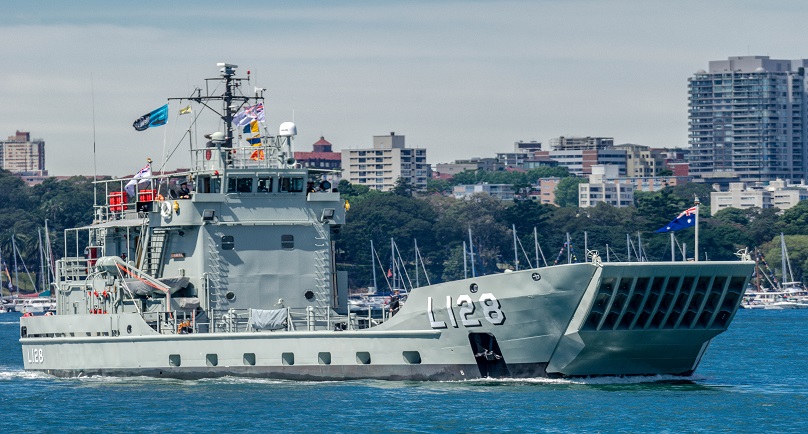By Sasha Pei-Silovo – EM TV Online
Australia continues to support the unified armed forces of Papua New Guinea, this time through the “gifting” of the HMPNGS Lakekamu, a landing craft heavy (LCH) vessel to be used for training by the maritime element of the PNGDF – the navy.
The Papua New Guinea Defence Force staged a ceremony to commission the HMPNGS Lakekamu, a Balikpapan class landing craft heavy (LCH), formerly known as the HMAS Labuan (L 128) of the Royal Australian Navy.The commissioning was held on Thursday 4 December 2014, fulfilling the commitment made by the Abott-led Australian government in 2013.
HMPNGS Lakekamu, named after the Lakekamu River in the Gulf province, is the first PNGDF vessel to be named as such.
The gesture by the Australian government is timely and is well received by the PNGDF, in particular the navy, with the HMPNGS Lakekamu to boost training of personnel.
The PNG Navy faces a shortage of equipment and underfunding; with the majority of facilities, equipment and patrol crafts barely effective, and the heavy landing craft having just about reached the end of its service life.
It was recently revealed by the PNGDF Navy, during the 40th year anniversary that patrolling Papua New Guinea’s large Exclusive Economic Zone (EEZ) is too great a task, considering the overall state of the PNGDF Navy.
Concerns have also been expressed by the crew of HMPNGS Seeadler, on their incapacity to operate on high seas. They said that in order to effectively carryout sea surveillance they needed a much bigger vessel and with only 20 personnel onboard per ship.
Navy manpower shortage is another growing concern; so as the issue of the relocation of the naval base to Gavuone village in the Marshall Lagoon area of the Abau District of Central Province, 81 miles (130km) south east of Port Moresby.
According to Australia’s Defence Minister, Senator David Johnston, the Royal Australian Navy decommissioned the heavy landing craft from Australian service last month in Cairns, and was given to the PNGDF to be used as a training vessel to enhance the development of mariner skills and “seaworthiness culture” in the PNG Navy’s workforce.
The HMAS Labuan was decommissioned from the RAN after 40 years of service, along with two other RAN vessels Brunei and Tarakan.
HMAS Labuan (now HMPNGS Lakekamu) was laid down by Walkers Limited, at Maryborough, Queensland on 1 November 1971, launched on the 29th of December of that same year, and commissioned into the Royal Australian Navy on March 9, 1973. The vessel had been named after Labuan, an island off the east coast of Sabah, and the “amphibious operation that took place there” during the 1945 Battle of North Borneo.
The LCH vessel is 44.5 metres long, has a draught of 1.9metres, with a beam of 10.1 metres; and has a standard displacement of 316 tons with a full load displacement of 503 tons.
According to the RAN, the landing craft heavy vessel is propelled by two G.M. Detroit 6–71 diesel motors that provides 675 brake horsepower to the two propeller shafts, allowing the vessels to reach nine knots – 17 kilometres per hour or 10 miles per hour.
The vessel can accommodate for 13-strong and can ably transport cargo in large quantities, equipment and military troops to shore, off from heavy ships.
The Australian Defence Minister, Senator David Johnston said HMAS Labuan was sailed by a combined RAN and PNGDF crew to Port Moresby. The minister is due to visit Papua New Guinea for the Australia-Papua New Guinea Ministerial Forum on December 15. This will be his second defence ministers’ meeting with Papua New Guinea’s Defence Minister, Dr Fabian Pok.
According to Wikipedia, the Balikpapan class vessels are equipped with a Decca RM 916 navigational radar, and fitted with two 7.62 millimetres (0.300 in) machine guns for self-defence.
The LCH vessels have a maximum payload of 180 tons – which is equivalent to “three Leopard 1 tanks, 13 M113 armoured personnel carriers 23 quarter-tonne trucks, or four LARC-V amphibious cargo vehicles”.
A Balikpapan class vessel, as a troop transport, is able to transport up to 400 soldiers between a larger vessel and the shore, or embark 60 soldiers in six-berth caravans for longer voyages, however, the “flat, box-like keel causes the ships to roll considerably in other-than-calm conditions”, thus limiting their ability to make long voyages.


